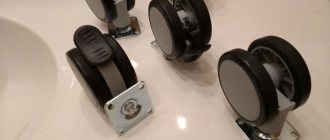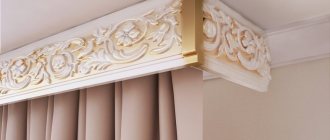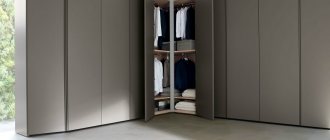Home / Lighting devices / Lamps
Back
Published: 05/08/2021
Reading time: 22 min
0
2711
- How to remove a light bulb from a suspended ceiling Replacing MR16, GU5.3 lamps
- Replacing lamps type GX53 (tablet)
- LED
Ceiling structures of suspended and tension type are equipped with various types of lighting fixtures. Most often these are spotlights - small-sized spotlights of low power, located in a certain order. By distributing them over the area of the ceiling and walls, directing beams of light or scattering them, designers zone the space.
As a result, per square meter of room there are sometimes 1-2 light sources that require scheduled maintenance or replacement in case of failure. It is difficult to complete this task without knowledge of electrical engineering and the design of a specific model, but it is possible. A plasterboard ceiling, although fragile, can still be manipulated by a non-specialist with a minimum of damage to the structure, while a tension fabric does not forgive mistakes, and in the event of a puncture or cut it can burst along the way. The situation is complicated by differences in the design of fastening systems used by different companies, so it is necessary to consider the features of the main types and models.
Types of lamps used in suspended ceiling structures
Several types of lighting fixtures can be used in suspended ceiling systems:
- Halogen. This type of lamp produces diffused light, which is best perceived by the human eye. A halogen lamp can be installed with the smallest gap, and the service life of the device depends on whether the installation is carried out correctly. If you buy low-voltage elements, then they are suitable for use in rooms with high humidity. However, this version of the lighting device does not tolerate sudden voltage surges, which is why it can fail much faster. This issue can be solved with the help of a voltage stabilizer, which experts recommend installing. Replacing a failed halogen lamp, especially if it is built-in, is much more difficult than a regular one. By carrying out the work in stages, every home craftsman can cope with this task.
- Anyone can replace standard incandescent lamps. After all, everyone without exception had to do this kind of work.
- LED lighting sources. By installing a high-quality LED lamp, for example, “Ekola”, in a spotlight, you can create very beautiful panoramic lighting, and this option is the most durable and economical.
- Energy saving option. Such models consume the least amount of electricity. However, experts do not recommend using energy-saving lamps in rooms with high humidity. For example, in saunas or baths. The service life of such models directly depends on the number of on and off cycles, that is, the more often the lamp is turned on and off, the shorter its service life will be.
Knowing what type of lighting fixture is used in a suspended structure, it is much easier to independently replace a lamp that has become unusable.
Unscrewing the light bulb in the suspended ceiling
Currently, hanging structures can be considered the most popular ceiling design option. They are able to completely transform the interior of a room, making it more spectacular and original. One of the advantages of such structures is the ability to hide various communications in them. Particularly attractive is the opportunity to equip built-in lamps. Such sources can be equipped with various types of lamps:
- Standard
- Luminescent
- Halogen
- LED
The design of built-in lamps is mostly the same. Therefore, it is enough to get acquainted with the common elements to understand how to replace standard or energy-saving light bulbs if necessary.
The main components of the design are:
Spotlights most often use halogen bulbs, which have to be changed no more than once every three years. If you need to make a replacement, you need to turn off the electricity in the room. First, remove the ring that secures the lamp. Then the plastic cover is dismantled, the burnt-out light bulb is unscrewed from the socket and a new one is installed. Some built-in sources hold the bulb in place using pins. In this case, it is carefully inserted with light pressure. If there is a click, the light bulb has taken its place.
Replacement must be done carefully, given that the ceiling material can be easily damaged. Experts recommend screwing in a new halogen light bulb with cloth gloves or using a dry cloth. It is noticed that in this case it will last longer.
How to change light bulbs in a suspended ceiling
As practice shows, in order to emphasize the beauty of PVC canvas, spotlights are used, which are placed in a certain order. Replacing a light bulb in a regular chandelier is quite simple, while with PVC sheets things are much more complicated. To remove the light bulb, you have to remove the entire device. The step-by-step algorithm of actions completely depends on the type of lamp used.
It is important to take into account the fact that you can often find lighting devices with LEDs on sale that are one piece. In such cases, the entire device must be replaced
Attention! If there is a need to change a spotlight on a suspended ceiling or replace a light bulb, it is better to do this as soon as possible.
How to change an LED lamp in a suspended ceiling
Today, LED lamps are especially popular. This demand is due to efficiency and fairly bright lighting.
To remove a lamp from a suspended ceiling, you should adhere to the following rules:
- check the serviceability of the lamp using a tester and turn off the electrical power in the entire room;
- take care of the presence of autonomous lighting if the room is dark for installation;
- remove the fastenings and remove the insulation from the electrical wires;
- replace it according to the instructions supplied with the new lamp;
- connect all wires, ensuring reliable insulation;
- install the lamp cover.
Despite the fact that LED lamps also have to be changed periodically, they are still more economical than other types.
How to change a halogen lamp in a suspended ceiling
As practice shows, halogen lamps installed in lighting structures on PVC fabric are much more difficult to replace than other types. Despite the presence of some difficulties that may be encountered during work, halogen lamps have some advantages, among which the following points can be highlighted:
- such light sources emit a rather soft and pleasant luminous flux, which is perceived quite well by humans;
- The service life is about 5 years, and if we compare the indicator with conventional lamps, then this period is impressive.
Before unscrewing the light bulb in the suspended ceiling, you will need to turn off the electricity. Once you have gained access to the halogen lamp, you will need to remove the fasteners and carefully remove the lamp from the socket.
How to unscrew a stuck light bulb from a stretch ceiling
Often you may encounter a problem when you need to remove a stuck light bulb from a stretch ceiling. Such problems occur very often. In such situations, some effort is required to remove the flask. If this doesn't help, you can try using pliers.
How to change a light bulb in a suspended ceiling: video
As practice shows, to carry out work on replacing lamps in a lamp, you need to adhere to a certain step-by-step work algorithm. If it is not possible to replace a light bulb in a suspended ceiling in this way, you can watch a video on this topic and clearly see all the stages of installation and dismantling of lighting fixtures on PVC canvas.
Replacing a lamp in a luminaire
To replace a light bulb, dismantling the device in most cases is not required, but turning off the power supply to the lamp, as practice shows, is not at all superfluous.
You also need to choose a reliable support, for example, a stepladder, but a hard chair will do just fine.
When replacing a lamp, as when dismantling a lamp, you should be careful, carefully and without haste - otherwise you can easily damage the canvas. When working, it is necessary to use screwdrivers, and not other sharp objects.
The procedure for replacing a lamp in a suspended ceiling is as follows:
- Remove the calcined wire ring that secures the lamp in the lamp body. In this case, the ring must be carefully held, eliminating the possibility of spring-loading it.
- The lamp is unscrewed.
- A new light source, equal or similar in power to the one removed, is installed and screwed into the vacant space;
- The fixing ring is installed and secured in place.
Upon completion of work, the power supply is turned on and voltage is supplied to the newly installed lamp.
Some models of LED lamps are a non-separable device. In this case, replacing the lamp is impossible and you will have to completely replace the entire lamp.
Replacing GU5.3 and MR16 products in a suspended ceiling
Lighting fixtures that are installed in suspended ceiling structures have two main parts:
- functional;
- decorative
Functionality includes frame and clamps.
The replacement work consists of 4 stages:
- Power cut
. First of all, you should de-energize the room where the replacement is to be done. For this purpose, turn off the automatic lighting circuit in this room. It is permissible to use a switch for the lamp, but you cannot be sure that it will break the zero and not the phase. The fact is that if the craftsmen made a mistake when arranging the lighting, then the phase wire will remain energized, even when the light is turned off. It is better not to put yourself at risk and carry out all power outages directly in the panel. - Removing a burnt out light bulb
. First, remove the main retaining ring, which acts as a retainer. To do this, you need to remove two antennae, after which the light bulb itself falls out of the housing, while it hangs on the contact socket. It is then removed from the contacts by turning the GU10 model counterclockwise or by pulling the MR16 towards you. - Installation of a new lamp
. Before replacing a light bulb in a suspended ceiling, it is necessary to compare the power and voltage indicators on the new product with those on the burned-out one. Lamps can have the same shape and different supply voltages. For example, instead of 220V it will be 12V. The main thing is that the power matches or does not exceed the previous value, otherwise the lamp will most likely overheat or, if there is a power supply, it will be overloaded. When all the data matches, plug connectors are inserted into the contact sockets of the lamp being installed on the socket. - Installing the lamp in its original place and fixing it
. Again use the retaining ring. His ears are squeezed, placed in the grooves and released. After the light bulb is secured, turn on the lighting.
There are models that do not have retaining rings. In this case, before changing the LED lamp in the suspended ceiling, you will need to completely remove the lamp from the ceiling structure.
The reasons for this may be the following:
- the springs deformed the housing of the lighting device;
- since the springs are of the wrong size, they begin to put excessive pressure on the body - this usually happens when several light bulbs are replaced at the same time, when the rings are mixed up and not installed in the same places;
- The ceiling structure is mounted at an insufficient distance from the ceiling and the lamp and socket rest against the plaster.
Removing chandeliers and lamps from a suspended ceiling
Stretch ceilings can serve for many years, but the lighting fixtures located on them become boring or fail after some time. To carefully and without consequences remove a chandelier or spotlight, you need to refer to the method of their installation. As a rule, the lighting system is designed before installing the tension fabric. Special rings for small lamps and mountings for large chandeliers are fixed to the ceiling. Markings are applied to the canvas and thermal rings are installed in certain places. They are made of plastic and serve to make a hole for the lighting fixture. Through it, a spotlight is secured into the mounting ring using latches or a chandelier is installed. The edges are covered with decorative trims for the devices.
Installation of fixtures for lamps and laying of wiring occurs before installation of the tension fabric
Before removing any lighting element, it is important to turn off the power to the room. Then you should unscrew the light bulbs
To dismantle the spotlight, use a flat, blunt object to carefully bend the edge of the strip. When there is a sufficient gap, you need to stick your fingers in there and grab the body of the device, pressing its latches. After this, it can be easily removed from the ring and pulled out into the hole.
When the lamp is removed from its mounts, it is important to ensure that your fingers are not pinched by the latches.
To dismantle the chandelier, decorative nuts or caps are removed and its mounting platform is disconnected. If the chandelier was additionally hung on a hook, then you need to insert your hand into the hole and remove it. To release the contacts of the device, be sure to use the instructions.
An assistant may be required to remove massive and heavy chandeliers.
The remaining fastening rings and circles can also be removed later or other devices can be hung in their place. And the grooves in the tension fabric can be carefully glued and painted over if desired.
By following all the instructions, you can dismantle the suspended ceiling yourself or remove any lighting fixture from it without damaging the coating. However, if you have little knowledge and experience in such matters, do not neglect the help of professionals, because warning is much cheaper than restoring everything.
How to change a light bulb in a spotlight on a suspended ceiling
Depending on the type of socket, light bulbs are removed differently. Let us consider in detail the replacement process for each type of base. Before starting work, it is better to turn off the power supply at the panel, otherwise there may be an electric shock.
G5.3
It is not very convenient to remove light bulbs of this type from spots, since the outer part is recessed into the lamp body and is located above the plane of the stretch ceiling. In the lampshades they are held in place using a special retaining ring or a wire clamp with antennae at the ends. Such lamps are compatible with LED and pin-type halogen elements.
To change a light bulb with a G5.3 socket, you need to squeeze the two antennae and pull out the fixing bracket. If a retaining ring is used as a retaining part, it is simply unscrewed. The lamp falls out. Then you need to disconnect it from the contacts by pulling it towards you. After this, a new lamp is connected, inserted into the lamp body and the fixing ring is installed in place.
Sometimes the retaining ring does not fit back in after replacing the light bulb. This happens for several reasons:
- the body is deformed - it will have to be replaced;
- the ceiling is fixed too high and the base rests on the concrete base - you need to purchase a lamp of exactly the same size, a difference of 1 mm can cause a problem;
- The fasteners are the wrong size - this happens if you had to unscrew several light bulbs and the rings were mixed up.
GX53
In luminaires with a GX53 base, the lamps protrude beyond the ceiling by 3-4 mm. On their back side there are two contact pins that are inserted into the corresponding grooves on the body of the lighting fixture. Dismantling is carried out by turning the lamp counterclockwise until it clicks, then it is simply pulled out.
Replacement is very easy; there is no need to install fixing parts or disconnect wires. Simply insert the new lamp and turn it clockwise.
G4, G9
The design feature of such lamps is that the body protrudes beyond the plane of the ceiling. LED and halogen pin-type models are available with G4 and G9 sockets. To dismantle the lamp, just pull it down. Then simply insert the new one into the groove. There is no need to rotate the lamp. In some models, you first need to disassemble the spotlight, namely, unscrew the decorative diffuser.
E14, E27
Such lamps are changed in the same way as in a regular chandelier or sconce.
Holding the flask, carefully unscrew it counterclockwise. Then screw the new one in until it stops, but without effort.
Sometimes the light bulb is difficult to grasp with your fingers, in this case you can use masking tape.
Removing a chandelier from a suspended ceiling
Stretch ceilings are equipped not only with spotlights. Quite often, traditional chandeliers are installed on them using special mounts. The work of removing a chandelier is much more complex and difficult than dismantling spotlights, so in some cases an assistant may be needed. Before starting work, the electrical network must be de-energized. The dismantling procedure itself is suitable for most modern chandeliers and is performed in a certain sequence.
The complexity of the work depends on the type of mounting of the lighting fixture. If hanging on a hook is used, then to access it you need to remove the protective cap. Inside there are wires connected to each other and protected with insulating tape. It must be removed, and the exposed wires must be checked, just in case, with an indicator screwdriver to make sure there is no current. After this, the wires are disconnected and the chandelier is removed from the hook. Installing the lighting device in its place is carried out in the reverse order.
Types of lamps and recommended lamp power
According to the installation method, spotlights are divided into two types:
- Built-in. The main part of the device is hidden behind the canvas. The bottom edge is at the same height as the ceiling and does not protrude beyond it. Because of this, the overall level of the structure drops slightly. With this arrangement, the spots are less noticeable, but the flow of light is more narrowly focused. The lamp and the canvas around it heats up more and takes longer to cool down.
- Invoices. The lamp is fixed at ceiling level, and the body is located below. When placed outdoors, the device is more noticeable, but it cools faster and illuminates the space more evenly. This type is safer to use.
The body is made from different materials: glass, crystal, aluminum, plaster, plastic. The shape can be round, square or rectangular. To choose the appearance, take into account the overall style of the room. It is advisable to purchase lamps designed specifically for suspended ceilings. They are designed in such a way that the rays do not shine through the canvas around them. Drywall is a denser material, so suspended ceilings do not have such problems.
There are several types of light bulbs:
- Incandescent lamps. They are almost never used with suspended ceilings, as they get very hot.
- Halogen. A relatively expensive option and they also generate a lot of heat.
- Energy saving. They are convenient where constant lighting is required, and when turned on frequently they consume a lot of electricity.
- LED. Economical and durable, practically do not heat up.
The most common types of base:
- G5.3 (for halogen and LED lamps);
- GX53 (led and energy saving);
- G9 (halogen and LED for surface-mounted luminaires).
Previously, only light bulbs operating on 12V voltage were produced. A transformer was required to connect to the power supply. Now there are lamps on sale that operate directly from 220V.
How to replace a lamp
The easiest way to change is the lamp located in the socket. To do this, you need to turn it counterclockwise. If energy-saving light bulbs are used, do not press them too hard. Change it carefully and slowly so as not to spoil it.
If the lamp looks like a flat surface on the ceiling and does not protrude, and inside it there is an element similar to a bulb, then it is a halogen type. It uses several pins to secure it and is more difficult to replace. Before starting work, turn off the power supply. In this case, you need to do this not in the room, in the electrical panel. Then prepare a surface that you can stand on. It must be reliable and strong. Please note that replacing a light bulb will require you to be careful and slow. Otherwise, you may damage the ceiling finish, mirror coating, etc.
First, unlock the mechanism that secures the lamp. For this purpose, the mechanism is equipped with a special ring made of metal wire. Gently holding the lamp body, bend this ring, thereby releasing the lamp. Then it is simply removed and replaced with a new one. First make sure that the new lamp matches the old one in terms of power.
Types and features
Before replacing a light bulb, you need to find out its type and purchase a new one. When choosing a lamp, you will need to take into account several characteristics.
Base
An important element of any light bulb is the base. The purpose of the element is to connect the conductive parts of the lamp and the corresponding socket. Lamps may have the same glass bulb, but differ in the type of base.
The marking of the base is determined on the basis of an internationally accepted standard, which allows you to purchase the desired option, knowing the combination of letters and numbers. The first letters in the marking indicate the shape of the base, and the numbers indicate the distance between the contacts, thread diameter or external dimensions of the base body.
Threaded
Threaded sockets are often used in incandescent lamps and energy-saving lighting sources. This variety is known to many as the Edison base
When choosing lamps with a threaded base, you need to pay attention to the numbers in the marking, which in this case determine the outer diameter of the thread
Pin
A type of pin base is designated by the Latin letter G. A pin system is used to connect the light bulb to the socket. The numbers in the name indicate the gap between the central parts of the pins, and if there are a large number of pins, the diameter of the circle on which their centers are located.
Bayonet
This type of base has a modified design of the threaded element. The function of the thread is performed by pins located on the sides, on which the light bulb is fixed in the socket. Depending on the manufacturer, the bayonet base is marked with the Latin letter B or Russian Ш. The number of contacts is indicated before the letter, and the diameter of the case after the letter. Thanks to precise fixation, bulbs with a bayonet base can be two- or three-pin.
Lamp type
In addition to the type of base, when replacing a light bulb in a suspended ceiling, you need to know its type. There are several types of lamps that have distinctive characteristics and features.
Incandescent
Incandescent lamps are the most common option and are light sources that emit a stream of light due to the incandescence of a tungsten conductor. The refractory metal has a high melting point, which is why it is used in lighting devices. The filament is placed in a glass bulb filled with an inert gas to protect against oxidation. Low power incandescent lamps are produced without the use of inert gas. The advantages of this type include:
- affordable price;
- instant on;
- large power range.
In comparison with other varieties, several negative aspects can also be identified. For example, a short service life and low efficiency, since only a tenth of the electricity consumed is transformed into light radiation.
Halogen
Halogen lamps are similar in design to standard incandescent lamps. Inside a large flask made of transparent or frosted glass there is a thin tungsten filament surrounded by a gas mixture. As a result of applying current, the thread heats up to 2500 degrees. When heated, the tungsten filament glows white, but the illumination depends on the color of the bulb.
Luminescent
Fluorescent lamps are made in the form of an oblong glass tube, sealed on both sides. The inside of the tube is coated with phosphor, and the space is filled with inert gas. The lamp also contains small amounts of mercury, which heats up and creates mercury vapor. The glow of fluorescent lamps is based on the heating of a tungsten element and subsequent radiation, which is absorbed by a special composition, which produces a bright light.
High power of fluorescent lighting sources is possible thanks to the internal phosphor coating. With the same electricity consumption, the power is higher than that of incandescent lamps, so the fluorescent type is also considered energy-saving.
LED
The main feature of the LED lamp variety is reduced energy consumption. Another advantage is the long service life, which can reach 100 thousand hours. LED products can work with any voltage and there is no need to additionally install ballast resistors.
Halogen lamps
Such lamps have recently become increasingly popular. Of course, they have plenty of advantages, but practically no disadvantages. They provide natural diffused light that is easily perceived by the human eye. Of course, one halogen light bulb will not be able to provide the necessary lighting, but when united in a group, they create a complete light source. The average lifespan of such lamps is 3-4 years, and if it fails at the end of the specified period, replacing it will not be difficult.
So, how to replace a halogen light bulb:
- Turn off the electricity;
- Pull out the fastener that secures the light bulb;
- carefully disconnect the bulb that has failed from the socket;
- take a new lamp and attach it in place of the one you pulled out;
- Place the lamp in its original place and secure it using a special fastener.
Now you know how to change a light bulb in a suspended ceiling, but before you buy a new replacement, we advise you to unscrew the old lamp and take it with you to the store. This way you won’t go wrong when choosing the right model.
Since all types of lamps are identical in their structure, the technology for replacing them is not particularly different. But we still offer you to watch a video about replacing a light bulb in a spotlight.
Previous articles from the category:
Options for placing spotlights on the ceiling
Even installing the most fashionable chandelier model will not give you the ideal lighting effect; in any case, it will attract the attention of others to the maximum, and some areas of the room will not be sufficiently illuminated. All this can be easily avoided if you make the correct placement of spotlights on the ceiling
Lighting for suspended ceilings - photo gallery
The idea of suspended ceilings goes back to ancient times, when ancient craftsmen decorated the ceilings of nobles and kings with silk fabric. The stretch ceiling looked luxurious and captivated the eye. Today, when lighting for suspended ceilings was invented, the most daring ideas have no boundaries - these are twinkling stars and the fiery sea of sunset...
Installing a chandelier on a suspended ceiling
You decided to renovate, which in our time is already a small feat, but as a final touch, you wanted to install a stretch ceiling and suddenly the question arose of how to hang a chandelier on a stretch ceiling? But I just want a chandelier...
Types of socles
Regardless of what type of lighting device is used to illuminate the room: energy-saving, halogen, LED, incandescent, you need to decide on the type of mounting. When choosing, the design of the lamp is taken into account. In order to figure out how to change a light bulb in spotlights, you need to learn about the types of bases.
What is a base? This is the part of the light bulb that is used to mount the structure in the socket. In addition, it serves to conduct electricity. Without a base, the lamp will not work. Despite this, baseless devices are sometimes used. They are designed to conduct light in automotive applications.
The design of the base is simple: the body is made of metal or ceramics. Inside are the elements of the light bulb, outside are the contacts for connection.
Each type is marked with letters and numbers. The letter means type, the number means characteristic.
Screw
The most common type for apartments is a screw base. Marked with the letter "E". This is the oldest type of light source mounting. Invented by Edison. The original name is “Edison Screw Type”, or Edison screw type. Hence the letter "E". The number indicates the outer diameter.
Among all Edison sockets, the most common is E27. Lighting fixtures with a diameter of 27 are the most popular in Russian apartments because it is easy to find a light bulb for them. E27 is equipped with traditional incandescent lamps, but has recently been found in halogen, fluorescent and LED lamps.
E14 is also found on the market. They call him "minion". This type is most often found in sconces, table lamps, but sometimes also in suspended and suspended ceilings. Less commonly used are “E” with diameters of 5, 10, 12, 26, and so on.
The main advantages are the prevalence and ease of fastening. There are no shortcomings observed.
Shtyrevoy
This type of base does not use a screw, but a pin connection system. The numbers indicate the distance between the centers of the pins. Used in halogen and energy-saving lamps. Denoted by the letter "G".
The G4 connection is used in small halogen light bulbs. Most often used for decoration, in spotlights, as well as in built-in lamps. There is a G9 type. Used in 220 V AC power supply, suitable for decorative lamps.
For office lighting use tubular G5. For compact lighting fixtures, there are sockets with four pins (2G10, 2G11). There are many such lamps. In order not to get confused when buying a new light bulb, it is recommended to take with you an old, burnt-out light source.
In addition to the types described above, there is the “GU” type. This means that the lamp is energy saving. The most common for suspended ceilings is GU5.3. Their thickness is 2.7 centimeters.
Bayonet
This type of connection is also called bayonet or pin. The source is installed in the lighting fixture by inserting and scrolling. Widely used for various purposes, most often in suspended, stretch ceilings and cars. The device operates in the presence of strong vibration.
This type of connection between a lighting fixture and a light source is often used in transport and more. For example, in the UK this is a standard connector.
Bayonet fasteners are usually designated by the letter “B”, and the number that comes after the letter indicates the outer diameter of the connector.
There are bases with different numbers of contacts (from 1 to 5). They are also designated by the letter:
- “s” - single contact;
- "d" - double;
- “t” - three contacts;
- "q" - four;
- "p" - five.
In everyday life, as a rule, lamps with one and two contacts are used. The rest are in production.
General rules and recommendations
When working with lighting devices, you must adhere to technology and follow safety rules:
- The scheme for replacing damaged products in suspended and suspended ceilings is no different, but in the case of suspended ceilings you should be more careful, since sharp objects can damage the canvas irrevocably;
- If you are going to install new halogen lamps, all work must be carried out with cotton gloves, since dirt and grease that gets on the bulb of the product cause the lamp to quickly burn out;
- If products with a threaded connection are difficult to remove (the base is burnt in the cartridge), additional force will be required, but in order not to accidentally injure your hand, the flask can be covered with tape;
- It is important to follow the product labeling and install lamps of the appropriate voltage (220 or 12V) in the device.
Recommendations for replacing lamps
When replacing lamps on a suspended ceiling, always adhere to the following rules:
- always turn off the power supply to the lighting fixture;
- you need to make sure the integrity of the wiring and the reliability of the contacts;
- always consider what voltage they are designed for;
- in case of mechanical damage to a fluorescent lamp, it is necessary to carefully clean the remaining traces when broken from the walls and ceiling, because they contain mercury vapor;
- if the halogen lamp cannot be pulled out, then it is better to remove the entire lamp, after which it can be easily removed;
- It is necessary to familiarize yourself in advance with the technical data and features of using certain types of light sources for a suspended ceiling.
For information on how to replace a light bulb in a spotlight, see below.
Replacing a lamp with a new one
Despite the fact that the LED surface lamp lasts quite a long time (the service life of even mid-price segment models is more than 50 thousand hours), in some cases it may be necessary to replace the device with a new one.
Before installing the lamp, the old one is dismantled. Before installation, a thermal ring is placed on the device, isolating the lamp from the surface of the material and preventing the ceiling from heating up. The new device is carefully inserted and secured inside the structural hole of the stretch ceiling to the platform installed on the adjusting posts.
The power supply is connected to the newly installed lamp.
Upon completion of work, a light bulb is installed in the lighting fixture
In this case, it is important to choose the right light source - its power should correspond to the power of the lamp declared by the manufacturer or be slightly less
Built-in lamps are most often used in suspended ceilings. They create comfortable lighting, allow you to properly distribute light fluxes, and many models are an additional decorative element. However, not everyone knows what to do if the light bulb burns out or the housing becomes unusable and needs to be replaced. This article will tell you how to properly remove a lamp from a suspended ceiling and install new lighting elements.
Type of lamps used in suspended ceilings
There are mainly four types of light bulbs used in suspended ceilings.
Halogen. This type can be installed with the least amount of space between the false ceiling and the main one. Halogen bulbs can light up a room quite brightly and are a little more difficult to replace than a regular light bulb.
Care must be taken when replacing. The service life of this type of lamp largely depends on proper installation
In the household network there are frequent voltage drops, which do not have a positive effect on the operation of the light source. For this, it is recommended to use voltage stabilizing devices.
Regular incandescent lamps. Each of us has known these products since childhood, and changing them does not require much difficulty or knowledge. But ordinary lamps have one significant drawback: they heat up quickly and therefore are not suitable for all types of suspended ceilings.
- Fluorescent lamps. This type of lighting, even despite its high cost, has become widespread. They are very economical and consume the least amount of electricity, and their lighting characteristics are much higher than previous models. They have a number of negative qualities - products with a hot start light up slower than other analogues, have a limit on the number of switches on and off, and they contain mercury vapor, which further complicates the disposal process.
- LED bulbs. A more economical and long-lasting option for this type of ceiling. Their brightness sometimes exceeds the similar characteristics of luminescent products. The operating period of LED lamps reaches 72,000 hours of production, while a conventional lamp has only 1,000 hours.
When changing different lamps, it is necessary to take into account that they use two types of base. The first is with a regular right-hand thread and is used for a classic cartridge. Most of us know how to change a light bulb with this type. The second option is a G-shaped base with different types, the lamps are installed using the two pins provided. These pins perform a guiding function, and strong fastening occurs after a characteristic click.
Types of lamps
The market is simply teeming with a variety of lighting devices, and each of them has its own mount, different from the others. In order not to get confused in all this diversity, we first need to understand the types of lamps and find out how to change any of them if necessary.
Halogen
Just five years ago it was the most common source of lighting for suspended ceilings. Its base is miniature, E10 or E14. The lamp itself is very small in size, but the light output is huge. It is called halogen due to the use of a special gas that prevents the coil from burning out and oxidizing.
In halogen lamps, the spiral is located at a very close distance from the protective bulb, and therefore it gets very hot during operation. So, if during the installation of the lamp you take a glass bulb, then the life of this lighting device will be reduced by 60%, or even more. This happens because you leave a fingerprint on its surface. The heat generated by the spiral is retained on this barrier, overheats the flask, and so it becomes unusable. By the way, our reader changed his lamps once a week precisely because of this.
Tungsten
It is also called Ilyich's lamp. Small base, E14. Tungsten lighting fixtures are also used in suspended ceilings. But they shine dimly, their service life is short, and their electricity consumption is very high. You should not pay special attention to such ones; you will definitely not be satisfied with their work.
LED
The most popular of the existing ones, it is small in size and lasts about 10,000 hours! Consumes literally a few watts, and the light output is phenomenal. Some quality LEDs are so bright that even just one small, one-watt LED can successfully illuminate an entire room.
There are dozens of varieties of these lamps with E27 and E14 sockets, but the most common are conventional horn mounts on suspended ceilings. That is, two male pin contacts and a corresponding female socket, which is always included in the kit.
LEDs operate on direct current, and at a certain power, so their design always includes a special inductor, that is, a transformer with a rectifier.
There is also an LED strip. The essence is the same as that of the lamp. But this device is made in the form of a tape with diodes arranged in series on it. It usually runs on power supplies, which are sold separately.
Luminescent
These lighting fixtures were all the rage 15 years ago, and many believed they would continue to dominate. They give a large, almost any spectrum of luminescence. The color depends on the gas used and sometimes on the coloring of the flask. Suspended ceilings use only E14 socles, which allows them to be dismantled like regular ones.
Fiber optic
It is more of a lighting and illumination system; during operation, it only requires a halogen lamp, which supplies light to the glass fibers.
Suspended ceiling as a light source
Before installing the suspended ceiling, a frame is assembled from wooden blocks or metal profiles, which are directly mounted to the concrete or wooden ceiling of the room. Then the ceiling covering itself is attached to the frame. The ceiling material for such a ceiling can be, for example, plasterboard. But such ceilings can also be suspended, in which the ceiling covering is made of strong synthetic material. These designs perfectly hide all defects in the main ceiling of the room and give it an even and smooth look.
Between these two ceilings (main and suspended), thanks to the assembled and fixed frame, a free space of up to 10 cm is formed. Electrical wiring for connecting future lighting and the main structural elements of the light source are hidden in this empty space. To connect lamps and various light sources, special holes are made in such a ceiling. A distinctive feature of this ceiling is the possibility of installing built-in lamps.
LED option
How to change an LED lamp in a suspended ceiling? It is believed that it is most profitable to install LED ones, since they consume little electricity. They also have a long service life. Such lamps are convenient and profitable because they do not require large expenses.
When the “tablet” burns out, people ask how to change the LED light bulb in a suspended ceiling. This process will not take much time and effort, you just need to follow a certain algorithm of actions:
- You need to turn off the electricity in the apartment.
- Don't forget about an additional light source, especially in the evening. A flashlight will come in handy when replacing a lamp.
- First of all, the mounts from the previous lamp are removed.
- It is necessary to remove the insulation from the wiring.
- Carefully disconnect the required wires.
- You must first study the instructions that come with the new lamp.
- A new LED lamp is installed in place of the old one.
- You should connect the necessary wires and secure the new light source. For this, special screws are used.
According to stores, most people purchase LED lamps for installation in suspended ceilings. The demand for them is constantly growing.
Precautionary measures
When working with electricity, it is important to follow safety precautions. Electric current when exposed to a person can be fatal. Therefore, it is important to turn off the electricity supply to the apartment before carrying out installation work.
All work must be carried out with gloves and glasses, in a convenient and safe place. You cannot change a light bulb using an uncomfortable and unstable stool or ladder. The process must be carried out carefully so as not to damage the canvas, ceiling lamp or electrical wiring.
Types of light bulbs
- Incandescent light bulb - has the highest luminous power, is not very durable and heats up noticeably. However, its size, shape and power vary over a very wide range, so changing it is not difficult. In addition, it tolerates voltage fluctuations well and is not too sensitive to moisture: it can be used in the bathroom either in a regular chandelier or in an Armstrong suspended ceiling module.
- Metal halide - has excellent light output and much better color rendering, can generate excellent daylight, and does not affect the shades at all. The durability of the device is higher, but the sensitivity to voltage drops, especially in the acoustic range, is high.
Before changing such a light bulb, you need to accurately determine its type. Devices are produced for a variety of purposes, including operation in a specific position.
Can be installed without restrictions in any type of lamp, including on a suspended ceiling. This is the most economical type of lighting, but is also sensitive to voltage changes and moisture: they are not used in the bathroom. In the photo there is a spotlight.
LED lamps have all the above advantages and are free from all the disadvantages: they are slightly inferior in light output to fluorescent lamps, withstand weather conditions well, are extremely durable, do not heat up and are completely safe. Can be used both in the bathroom and outdoors. There is only one thing - the cost.
Replacing an LED fixture is as easy as replacing a regular one.
Stages of replacing the light source
First, you should remove the lamp by removing the retaining ring that secures it to the ceiling. To do this, you need to carefully pick up the tendril, remove the ring and put it aside, as it will be needed for reinstallation. Then, depending on the type, you should carefully pull out or unscrew the light bulb from the socket, holding it with your free hand. Regular and halogen light bulbs simply unscrew. If it collapses, you should collect the fragments, and then unscrew the base using pliers, making sure that the cartridge is not damaged. In this case, it is also necessary to choose the correct size of the base.
Before installation, it is necessary to correctly determine the power and operating voltage of the lamp in order to ensure the desired level of illumination. You need to check the data on both lighting devices and their packaging, since, for example, there are LED lamps with a GU 5−3 base, designed for 12 and 220 volts. The power of the new source should be the same or slightly less than that of the old one. Otherwise, the lamp may overheat, and the power supply provided by its design may burn out. Do not handle the bulb of halogen lamps with dirty hands - this will significantly shorten their service life.
After a successful check, you can insert or screw the lamp into the socket. Then you should install the spotlight in its place. After this, you need to take the locking ring, squeeze its ears, insert the ends into the grooves and release. After making sure that the lamp is securely fixed, you can supply electricity to the house and turn on the lights.
How to dismantle a spotlight?
Replacing a spotlight on a suspended ceiling is a job that you can do yourself. Initially, you need to prepare a number of tools. Among them are the following:
- Insulating tape.
- Tester.
- Wire cutters to remove insulation.
- Crimping pliers. An alternative is ordinary pliers.
- Drill and long drill bit for concrete.
After everything necessary is prepared, dismantling should begin. It begins with de-energizing the line to which the device is connected. To make sure the actions are correct, use a tester to check the line. The next step is to disassemble the junction box, from which the wires are additionally disconnected. After this, remove the old lamp.
Dismantling is carried out according to the following algorithm:
- The lamp is unscrewed from the housing, which is mounted in the suspended ceiling. To do this, use a straight screwdriver, which is used to pry up the decorative rim.
- Another screwdriver is inserted into the resulting gap.
- The body is unscrewed evenly until there is a gap into which the fingers can fit.
- The latches are pressed with your fingers and the product is removed from the groove.
- To release the contacts, you need to unscrew the screws located on the terminal block.
If you have any questions, watch the video. It will allow you to understand the intricacies of installing the lamp and, if necessary, its subsequent dismantling. In this case, the suspended ceiling will not be damaged.
Installation of spotlights on a suspended ceiling











